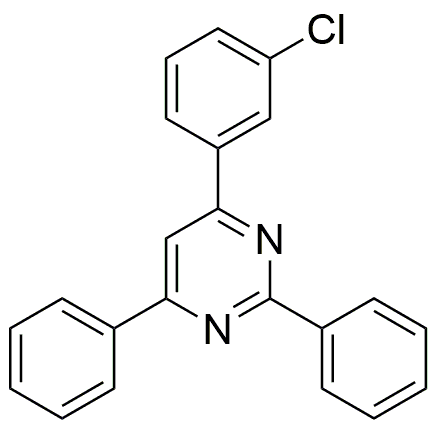4-(3-Chlorophenyl)-2,6-diphenylpyrimidine is widely utilized in research focused on:
- Pharmaceutical Development: This compound serves as a crucial intermediate in the synthesis of various pharmaceuticals, particularly those targeting specific diseases, enhancing drug efficacy and specificity.
- Anticancer Research: It has shown potential in studies aimed at developing new anticancer agents, offering a promising avenue for treatments that can selectively target cancer cells.
- Material Science: The compound is explored for its properties in creating advanced materials, such as organic light-emitting diodes (OLEDs), which are essential for modern display technologies.
- Agricultural Chemistry: It is investigated for use in developing agrochemicals, potentially improving crop protection strategies against pests and diseases.
- Biochemical Studies: Researchers utilize it to understand various biochemical pathways, aiding in the discovery of new biological mechanisms and therapeutic targets.
General Information
Properties
Safety and Regulations
Applications
4-(3-Chlorophenyl)-2,6-diphenylpyrimidine is widely utilized in research focused on:
- Pharmaceutical Development: This compound serves as a crucial intermediate in the synthesis of various pharmaceuticals, particularly those targeting specific diseases, enhancing drug efficacy and specificity.
- Anticancer Research: It has shown potential in studies aimed at developing new anticancer agents, offering a promising avenue for treatments that can selectively target cancer cells.
- Material Science: The compound is explored for its properties in creating advanced materials, such as organic light-emitting diodes (OLEDs), which are essential for modern display technologies.
- Agricultural Chemistry: It is investigated for use in developing agrochemicals, potentially improving crop protection strategies against pests and diseases.
- Biochemical Studies: Researchers utilize it to understand various biochemical pathways, aiding in the discovery of new biological mechanisms and therapeutic targets.
Documents
Safety Data Sheets (SDS)
The SDS provides comprehensive safety information on handling, storage, and disposal of the product.
Product Specification (PS)
The PS provides a comprehensive breakdown of the product’s properties, including chemical composition, physical state, purity, and storage requirements. It also details acceptable quality ranges and the product's intended applications.
Certificates of Analysis (COA)
Search for Certificates of Analysis (COA) by entering the products Lot Number. Lot and Batch Numbers can be found on a product’s label following the words ‘Lot’ or ‘Batch’.
*Catalog Number
*Lot Number
Certificates Of Origin (COO)
This COO confirms the country where the product was manufactured, and also details the materials and components used in it and whether it is derived from natural, synthetic, or other specific sources. This certificate may be required for customs, trade, and regulatory compliance.
*Catalog Number
*Lot Number
Safety Data Sheets (SDS)
The SDS provides comprehensive safety information on handling, storage, and disposal of the product.
DownloadProduct Specification (PS)
The PS provides a comprehensive breakdown of the product’s properties, including chemical composition, physical state, purity, and storage requirements. It also details acceptable quality ranges and the product's intended applications.
DownloadCertificates of Analysis (COA)
Search for Certificates of Analysis (COA) by entering the products Lot Number. Lot and Batch Numbers can be found on a product’s label following the words ‘Lot’ or ‘Batch’.
*Catalog Number
*Lot Number
Certificates Of Origin (COO)
This COO confirms the country where the product was manufactured, and also details the materials and components used in it and whether it is derived from natural, synthetic, or other specific sources. This certificate may be required for customs, trade, and regulatory compliance.


